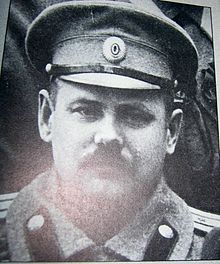| Mikhail Svechnikov | |
|---|---|
 Svechnikov in 1917 Svechnikov in 1917 | |
| Birth name | Mikhail Stepanovich Svechnikov |
| Born | (1882-09-30)30 September 1882 Ust-Medveditskaya, Russian Empire |
| Died | 26 August 1938(1938-08-26) (aged 55) Kommunarka shooting ground, Moscow, Soviet Union |
| Buried | Kommunarka shooting ground |
| Allegiance | |
| Service | Imperial Russian Army Red Guards Red Army |
| Years of service | 1901–1937 |
| Rank | Colonel (Russian Army) Kombrig (Red Army) |
| Battles / wars | Boxer Rebellion Russo-Japanese War First World War October Revolution Finnish Civil War Russian Civil War |
Mikhail Stepanovich Svechnikov (Russian: Михаил Степанович Свечников; 30 September 1882 – 26 August 1938) was a Russian military officer in the Imperial Russian Army and the Red Army. He is best known as one of the military leaders of the Red Guards during the Finnish Civil War.
Career
After his service in the Imperial Russian Army, Svechnikov took part at the 1917 October Revolution. During the 1918 Finnish Civil War he worked as a military advisor for the Red Guards. In February 1918, Svechnikov was shortly the Commander-in-Chief of the Northern Front, replaced then by Hugo Salmela. He was the highest ranked Russian officer who joined the Finnish Red Guards.
As the Finnish Civil War was over, Svechnikov fought in the Russian Civil War, in which he led the Caspian-Caucasian Front in the unsuccessful Northern Caucasus Operation (1918–1919).
Since 1922 he worked as a military lecturer. In 1934 Svechnikov was transferred to the Frunze Military Academy. He was arrested in 1937, accused on "Fascist conspiracy", and later executed at the Kommunarka shooting ground in Moscow. Svechnikov was rehabilitated after Stalin's death in 1956.
References
- ^ Свечников Михаил Степанович (Черушевы, 2014) (in Russian). Расстрелянное поколение. Retrieved 8 July 2015.
- ″Suomen itsenäistymisen kronikka″, Gummerus, 1992. ISBN 951-20-3800-5.
This biographical article related to the Russian military is a stub. You can help Misplaced Pages by expanding it. |
- 1882 births
- 1938 deaths
- People from Serafimovichsky District
- People from Don Host Oblast
- Imperial Russian Army personnel
- Russian military personnel of the Boxer Rebellion
- Russian military personnel of the Russo-Japanese War
- Russian military personnel of World War I
- Russian revolutionaries
- People of the Finnish Civil War (Red side)
- People of the Russian Civil War
- People executed for treason against the Soviet Union
- Great Purge victims from Russia
- Soviet kombrigs
- Russian expatriates in Finland
- Russian military personnel stubs